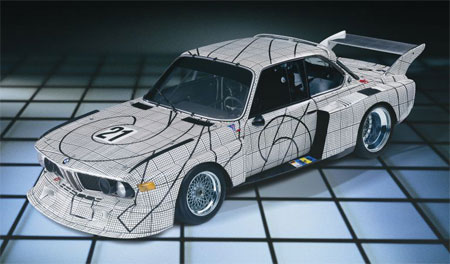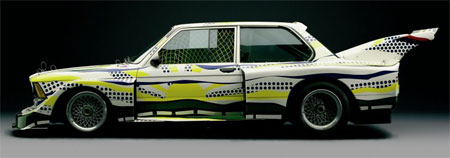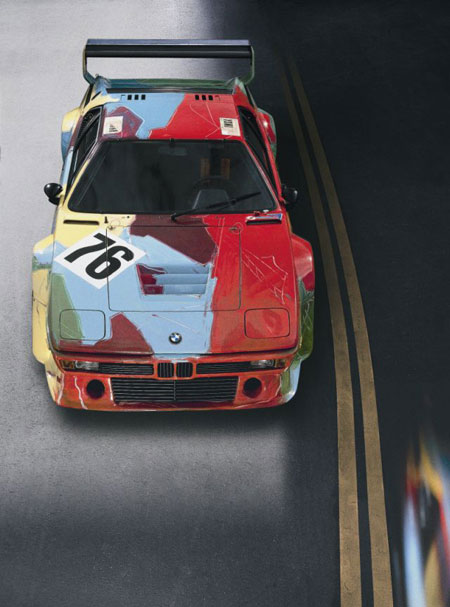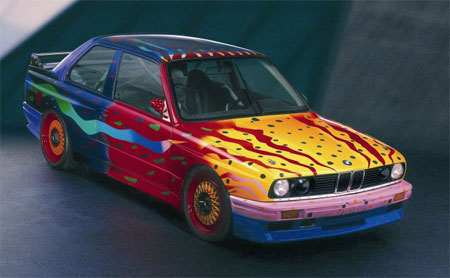 The BMW Group will be exhibiting it’s 4 BMW Art Cars in Asia, and the BMW Art Car Tour‘s first stop will be Malaysia. The BMW Art Car Collection was conceived by French race car driver and art auctioneer Herve Poulain, who sought to link his two passions – cars and arts.
The BMW Group will be exhibiting it’s 4 BMW Art Cars in Asia, and the BMW Art Car Tour‘s first stop will be Malaysia. The BMW Art Car Collection was conceived by French race car driver and art auctioneer Herve Poulain, who sought to link his two passions – cars and arts.
There are currently 15 BMW Art Cars, and 4 of them will be making their way to Malaysia. They will be displayed at the Petronas Art Gallery in Suria KLCC from September 14 2006 to October 22 2006.
Look after the jump for images and descriptions of the cars and respective artists, courtesy of BMW Malaysia Sdn Bhd.
Frank Stella 1976 – BMW 3.0 CSL

Frank Stella – American Minimalist Painter and Sculptor
His works of art can be found in Museums all over the United States including the Guggenheim in New York City.
Born in 1936 in Malden, Massachusetts, Stella began studying art at the Philips Academy in Andover at the tender age of 14 and went on to study history at Princeton. After this, he set up a studio in New York in which many of his much acclaimed “Transitional Paintings†and “Black Paintings†were produced. An exhibition of his works was held at the Museum of Modern Art as early on as 1959. During this creative period, the influence of the abstract Expressionists is unmistakable. His “post-abstractionist†work, mostly the large-scale pop-art paintings he produced in the 1960s are now considered art history. Between 1960 and 1980, Stella exhibited throughout the world, while continuing to work as a teacher. From 1978 to 1980, a traveling exhibition took place in the USA showing retrospective pieces of his work. His subsequent creative works since then consists of relief pictures.
“My design is like a blueprint transferred to the bodywork.â€- Frank Stella
Frank Stella not only converts his ideas into various media with dramatic diversity – he is also a passionate motor racing fan. For this reason, he was all the more determined to succeed as he set about the task of individually decorating a BMW Coupe back in 1976.
While working on his draft version, Stella disassociated himself from his usual random style of painting and sought inspiration from the cars technical aura. The result: a black and white square grid with an evenness and precision reminiscent of oversized graph paper. Within this grid, pattern-like, dotted lines run across the bodywork, suggesting that Stella may have wished to cut out the car and reassemble it in a new shape.
The grid pattern – a feature of both Stellas earlier and later creative periods – is often used by him as a kind of stage upon which a painted drama takes place. By way of contrast, the paintwork he created especially for the Le Mans race is not a stage, but the action itself. However, Stella was against any over-interpretation of his work. His own assessment was if anything reserved:
“The resulting colored pattern should be regarded as agreeable decoration.â€
Stellas Coupe took part in the 1976 24-hour race at Le Mans, but was not among the top finishers. After its debut, the car was entered for another race, this time for a Manufacturers World Championship event at Dijon in France. It was to be driven by Ronnie Peterson, a racing driver of international repute, and one of Stellas friends. Peterson, however was involved in a fatal accident during the Italian Grand Prix at Monza in 1978; in memory of his friend, Stella produced a series of paintings entitled “The Polar Co-ordinates for Ronnie Peterson.â€
Roy Lichtenstein 1977 – BMW 320i

Roy Lichtenstein – The father of American pop-art
Born in New York in 1923, Roy Lichtenstein is generally regarded as the father of American pop-art. In the years prior to 1938, he painted portraits of Jazz musicians. After this, he attended courses held by the “Art Student Leagueâ€, then went on to study art in Ohio. His subsequent work straddled cubism and expressionism. In the late 1950s, Lichtenstein began dealing with trivial culture such as comics and advertisements. His first pop-art pictures appeared in 1961, their monumentalisation of the banal heralding a completely new style of art. Following his caricatures of the “American Way of Lifeâ€, experiments with well known works of art and various sculptures and films, the Museum of Modern Art in New York held a comprehensive retrospective of Lichtensteins work in 1987. He died in New York in 1997.
“I thought hard, and put all I had into it.†– Roy Lichtenstein
Roy Lichtenstein can still remember vividly how he produced the design for his racing car – the BMW 320i – back in 1977:
“I wanted to use paint lines as a road, pointing the way for the car. The design also shows scenery as it passes by. Even the sky and sunlight are to be seen…you could list all the things a car experiences – the only difference is that this car mirrors all these things even before it takes to the road.â€
Taking a closer look, the cars design casts a picture of passing scenery in which both the car and its movement are one single entity. And although Lichtensteins comic art was already a thing of the past by then, his Art Car is clearly influenced by it: the long-drawn colored strips to act as “speedlines†– a feature used in comics to suggest speed. Even oversized dots used by Lichtenstein, the “Bendy Dotsâ€, are reminiscent of his famous comic-strip pictures.
The harmony achieved between the predetermined aerodynamic features and free composition is pure Lichtenstein. It is an expression of his artistic credo: art must be an element of everyday life – its theme and inspiration must come form the lives of ordinary people.
After its completion, Roy Lichtensteins Art Car celebrated not one, but two premieres: as a work of art at the Centre Pompidou in Paris, and as a racing car in the Le Mans 24-hour Race. It was driven by the Frenchmen Herve Poulain and Marcel Mignot. The car finished in 9th place overall and first in its class.
Andy Warhol 1979 – BMW M1

Andy Warhol – A synonymous name with pop art
Born in Pittsburgh, Pennsylvania in 1928, he studied from 1945 to 1949 at the Carnegie Institute of Technology and immediately after this, started a career as a successful graphic artist in the advertising sector. His work went on display as early as 1952 in New York; in 1956 he received the coveted “Art Directors Club Awardâ€. At his legendary “Factoryâ€, at which he employed a whole team of workers, classic art concepts were negated and overturned in an unprecedented manner. His “mass productions†of prominent faces became well-known, as well as painted trivialities such as soup tins and coca-cola bottles.
Warhol died in 1987 in New York. Two years after his death, the Museum of Modern Art dedicated a full retrospective exhibition to him.
“I adore the car. Its much better than a work of art.†– Andy Warhol
In keeping with Andy Warhols view of art, a car as a rolling work of art is more typical than unusual. Anybody who declares soup cans to be a work of art or suggests closing a whole department store and keeping it as a museum for posterity must be unable to sense any conflict between functional technology and free artistic composition. The studio therefore became a “factoryâ€, and the dichotomy between sophisticated art and everyday life was virtually eliminated.
Andy Warhol set about work in an equally unabashed manner after being commissioned to transform a BMW M1 into an Art Car as he thought best. All the other artists who had previously decorated BMW racing cars had done so by painting a draft version on a scaled-down model; this was them transposed to the actual car by assistants under the artists supervision. Warhol, however, was the first to paint everything himself. By transferring his ideas to the car in his spontaneous and direct manner, he could only clearly stamp his own character on it.
Warhol explained the sweeping strokes he chose as follows:
“I tried to portray speed pictorially. If a car is moving really quickly, all the lines and colors are blurred.â€
Ken Done 1989 – BMW M3

Ken Done – Creative, Optimistic and Bold.
Ken Done, born in Sydney in 1940, left school at the age of only 14 and commenced his art studies at the National Art School in Sydney. After working for 20 years as an advertising graphic designer in Sydney, New York and London, he quit his profession to devote more time to painting. Since his first exhibition in 1980, he has rapidly gained a reputation as a leading Australian painter, to complement his established credentials as a top graphic designer. In 1988 he was commissioned to execute the exterior design of the Australian and United Nations pavilions at EXPO. Highly talented, Done is often engaged on several projects simultaneously. The lively colours and brush strokes of his pictures reflect the typical face of Australia – landscapes, the animal kingdom, beaches and gardens. His works are on display at exhibitions and in museums and private galleries all over the world.
“I have painted parrots and parrot fish. Both are beautiful and able to move at fantastic speeds. I wanted my BMW Art Car to express the same qualities.â€- Ken Done
After assessing the impressive series of works produced by his illustrious predecessors, Ken Done considered the task of painting a BMW racing car a huge challenge and a “great complimentâ€. He compared it to playing Jack Nicklaus at golf or having a car race against Nelson Piquet. During the creative process he was particularly conscious that the Art Car represented a linking together of artistic and technical modes of thought.
Done had definite ideas from the very first moment as to how to decorate the car, On the one hand it was to express something of the fascination which the swift, high-performance M3 held for him, and on the other hand, it had to be typically Australian. The vitality and optimism of his home continent were to be much in evidence as things which he particularly appreciates about Australia. He therefore decided to paint parrots and parrot fish, as he saw a strong affinity between them and the BMW M3. The result is as appealing as it is original: Done has indeed succeeded in representing speed and beauty in his own unmistakably Australian style.
Ken Dones Art Car originates from the Motorsport Division of BMW Australia, formerly run by the famous Australian racing driver Frank Gardner. The car took to the road in 1987 with the JPS-BMW Team, carrying Jim Richards to victory in the Australian Group
Looking to sell your car? Sell it with Carro.








































They call it art. I call it ugly-especially the M1 and M3. I think normal stripes and colour scheme like NFSMW is better.
paul, u got typo error for the M1 picture caption "Any Warhol – A synonymous name with pop art"…as a car enthusiast and designer, i would definitely going to Art gallery, i wondering are they allow us to bring camera into the gallery…anyway, i hope the entry is free again…kekeke
Its a good job on the body with themes and designers' own creativity, just that those multi-coloured paint job is not my taste and style, there's really nothing wrong with those BMWs.
For all NFS Most Wanted and Underground's fans out there, I don't think u guys will like those designs too, most of u (including me…) will still prefer the cars exactly like those in the games, or just kinda like those cars from 2 Fast 2 Furious or TF&TF: Tokyo Drift movie, with those bling bling rims and cool bodykits.
But anyway, those BMWs above are just not some people's tastes, so please don't say that those were very ugly looking or bad……
Er, guys. These are artists. Probably having lil to do with automobiles. They are merely using the BMW as their canvas. lol. Unlike vinyls n airbrushing used to "beautify" our rides like NFSMW (awesome game). Anyways, love Frank Stella's work..Mmm..I could live with that on my car.
mystvearn said,"I call it ugly-especially the M1 and M3……….."
mitlanevo said., "…….just not some people’s tastes…….."
In my opinion, the artists as what Grey_Fox said, just used BMW as canvas
for their artisitic work to convey certain message/meaning as explain in the above literature!
I don't understand why would some people call some arts as "ugly". The cars are just part of the medium used in it. Just like when you are doing paintings on a box, on a bus, or Milo tins! Even if it does not pleases your eyes you shouldn't just go telling, it's ugly. That's plain rude.
Personally, I like the 3.0 CSL as it looks good on the car as graphic as well as an art. But if I have the M1 or M3, I wouldn't want to drive that on public road. You wouldn't want anybody to "accidently" scratch or bump onto your 'Van Gogh', would you? =) I'd rather have it inside my home gallery than leavin it rust and dust in the garage!
erm… no comment
aksMs said,
September 10, 2006 @ 11:35 pm
Just like when you are doing paintings on a box, on a bus, or Milo tins! Even if it does not pleases
you can double your art at one time on a Proton means on a car and MILO TIN at the same time…
but since the Proton is the problematic idiot you will ruin your mood to do it.
fugly
Hello
i agree with aksMs..all these bmw cars is only a medium for them to express their art skill or whatever. noting to do wit any automobile field. they are just putting their 'life' on it. and they are the worlds 's best pop art artist..so, dont compare it wit original color or some new paint job modification for normal car.cant compare at all. thats my opinion.
so dont say it ugly, try to appreciate it even lil bit..
damn true, can't force others to accept what we like….